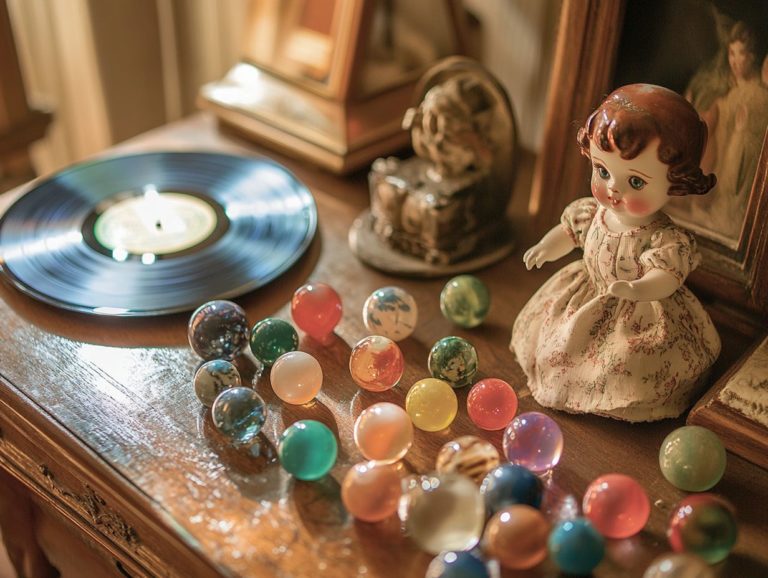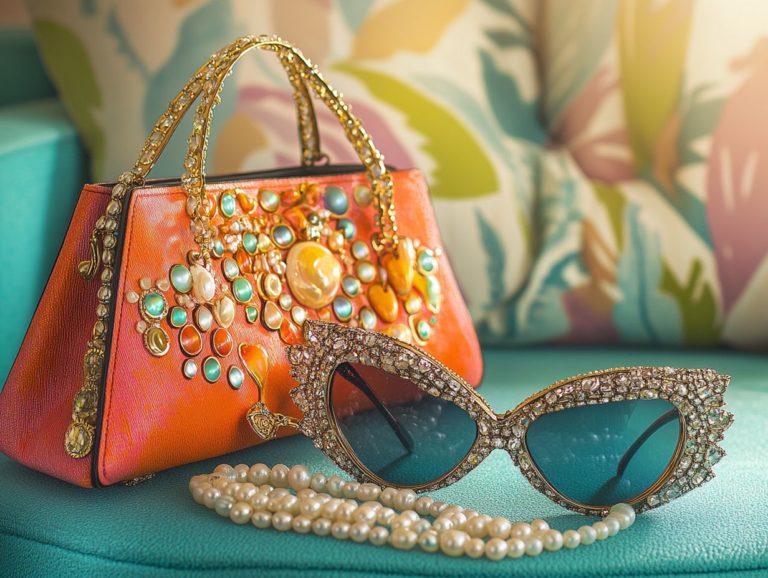The History of Vintage Collectibles and Their Value
Vintage collectibles possess an enchanting allure that draws in both enthusiasts and casual admirers alike.
From old items steeped in history to cherished toys and comics, these pieces narrate stories of past eras and their cultural significance. This exploration delves into the evolution of vintage collectibles, offering insight into what defines them and the historical context that underpins this enduring hobby.
You ll learn how to assess their value and discover various popular categories that comprise this vibrant collecting landscape. Get ready to dive into the fascinating world of vintage memorabilia and uncover what makes these treasures so sought after today.
Contents
Key Takeaways:
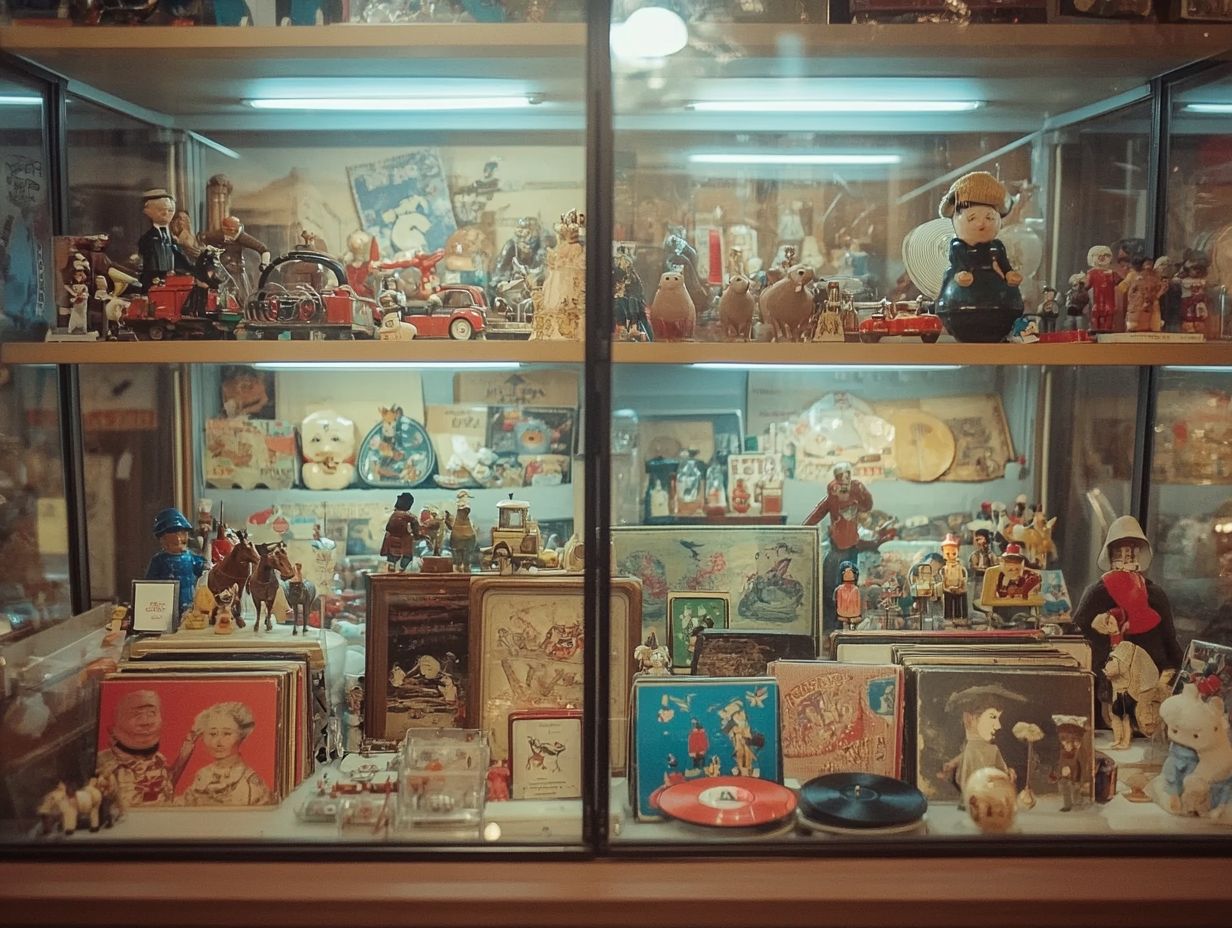
- Vintage collectibles hold historical significance and have been collected for centuries.
- The value of vintage collectibles can be determined by factors such as rarity, condition, and demand.
- Popular categories of vintage collectibles include antiques, memorabilia, toys and games, and comics and books.
The Evolution of Vintage Collectibles
The evolution of vintage collectibles presents a captivating interplay of historical significance, craftsmanship, and market dynamics. This influences how you perceive and value unique items.
From rare antiques to cherished vintage discoveries, you navigate a landscape steeped in history. Each piece narrates its own story and possesses intrinsic value within the ever-shifting collectibles market.
Grasping this evolution is essential for seasoned collectors and newcomers. It enriches your appreciation for these items and informs their potential as investments.
Defining Vintage and Collectibles
Defining vintage and collectibles is vital for grasping the expansive world of collecting. Items are categorized based on their age, rarity, and historical significance.
Vintage typically refers to items that are at least 20 years old, but haven t yet crossed into antique territory. Collectibles encompass a wider array of items that individuals acquire for their intrinsic value or sentimental significance.
This distinction is essential, as collectors often seek pieces that resonate with particular time periods, movements, or personal experiences. Antiques, generally regarded as items over 100 years old, possess their own unique allure defined not only by age but also by the craftsmanship and stories they carry.
The world of collectibles spans everything from stamps and coins to pop culture memorabilia. Each category attracts dedicated enthusiasts. The significance of an item often hinges on its historical context; for instance, a vintage toy may hold greater value if it signifies a pivotal moment in pop culture or technological advancement.
This allows collectors to appreciate not just the item itself but also the rich narrative it embodies within the broader tapestry of history.
Historical Significance of Collecting
The historical significance of collecting stretches back centuries. It is intricately woven into the fabric of art, culture, and human expression through the acquisition of items that capture the essence of their time.
By collecting antiques and vintage pieces, you reflect societal values and create a personal connection to your heritage. This preserves cultural artifacts that tell stories of the past.
As societies have evolved, so too have the motivations behind collecting. What once began as mere hoarding of valuables has transformed into a pursuit rich with personal narratives and collective memory.
Take the Ashmolean Museum in Oxford, for instance. It stands as a testament to the 17th-century practice of collecting curiosities, showcasing how private collections evolved into public institutions dedicated to education and cultural exchange.
Similarly, consider the influential collection of African art by philosopher and collector Marcel Griaule. His efforts not only highlighted the artistic diversity of the continent but also sparked a deeper understanding and appreciation within Western circles.
These examples illustrate how collecting can shape societal perspectives and foster connections across cultures. They reinforce the notion that curated objects are gateways to understanding historical contexts and artistic practices.
The Value of Vintage Collectibles
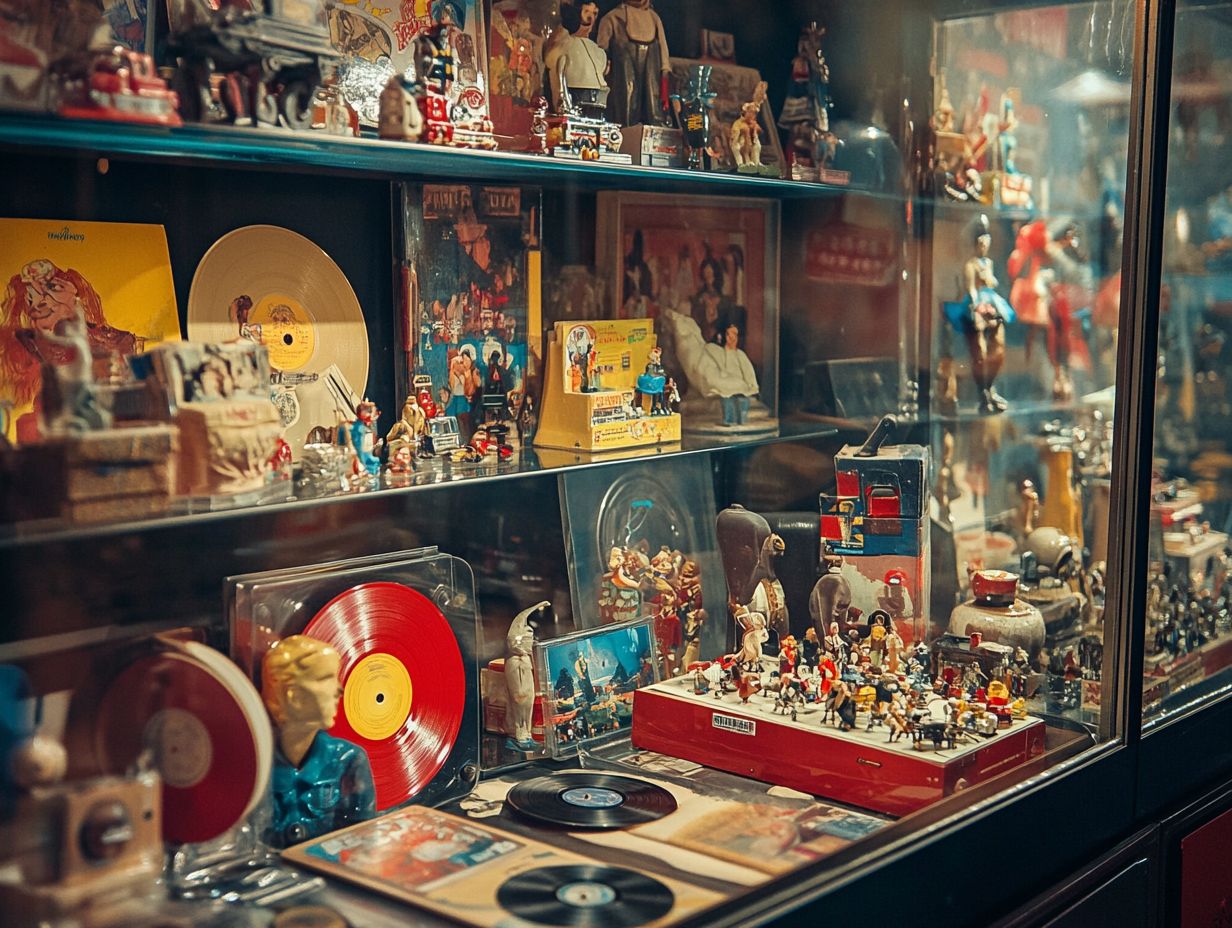
The value of vintage collectibles is influenced by many factors, such as rarity, condition, and historical significance. Understanding these elements is essential for making informed decisions about appraisals and investment opportunities.
This intricate interplay shapes the broader market for collectibles.
Determining Factors of Value
To determine the value of vintage collectibles, pay attention to rarity, condition, and market trends. Consider how often an item appears for sale and its historical significance.
Understanding these elements helps in forming an accurate appraisal. For example, a rare toy from the 1980s is valuable not just for its scarcity but also for its pristine condition and nostalgic appeal.
Vintage vinyl records can also command impressive prices if kept in pristine condition, with first pressings generally earning more respect in the marketplace. Economic factors, like shifts in buyer interest and cultural trends, can significantly affect perceived value.
By employing recognized appraisal methodologies and considering expert opinions, you can navigate these variables effectively, leading to a well-informed purchase or sale.
Appraisal and Authentication
Appraisal and authentication are essential aspects of the vintage collectibles market, ensuring that your items are accurately valued and genuinely reflect their storied histories. Engaging with specialists in the field provides invaluable insights that help you authenticate significant finds and assess their true market value.
The provenance of an item its documented history, prior ownership, and previous sales is crucial in establishing both its authenticity and value. The condition of your collectible, meticulously examined, can significantly sway its worth; even minor wear can lead to notable depreciation.
Experts utilize sophisticated tools, including advanced imaging technologies and chemical analysis, to detect forgeries and evaluate quality. These professionals not only impart knowledge but also guide you through the complexities of the market, enhancing your overall appreciation for the world of collectibles.
Popular Categories of Vintage Collectibles
Popular categories of vintage collectibles encompass a rich tapestry of items that captivate collectors from all walks of life. These categories include antiques, toys, memorabilia, and unique vintage finds.
Each category possesses its own distinct allure and market dynamics, presenting opportunities that blend nostalgia with investment potential. Whether you re drawn to the charm of yesteryear or seeking valuable treasures, the world of vintage collectibles offers something special just for you.
Don’t miss out on the chance to uncover hidden treasures in vintage collectibles!
Antiques
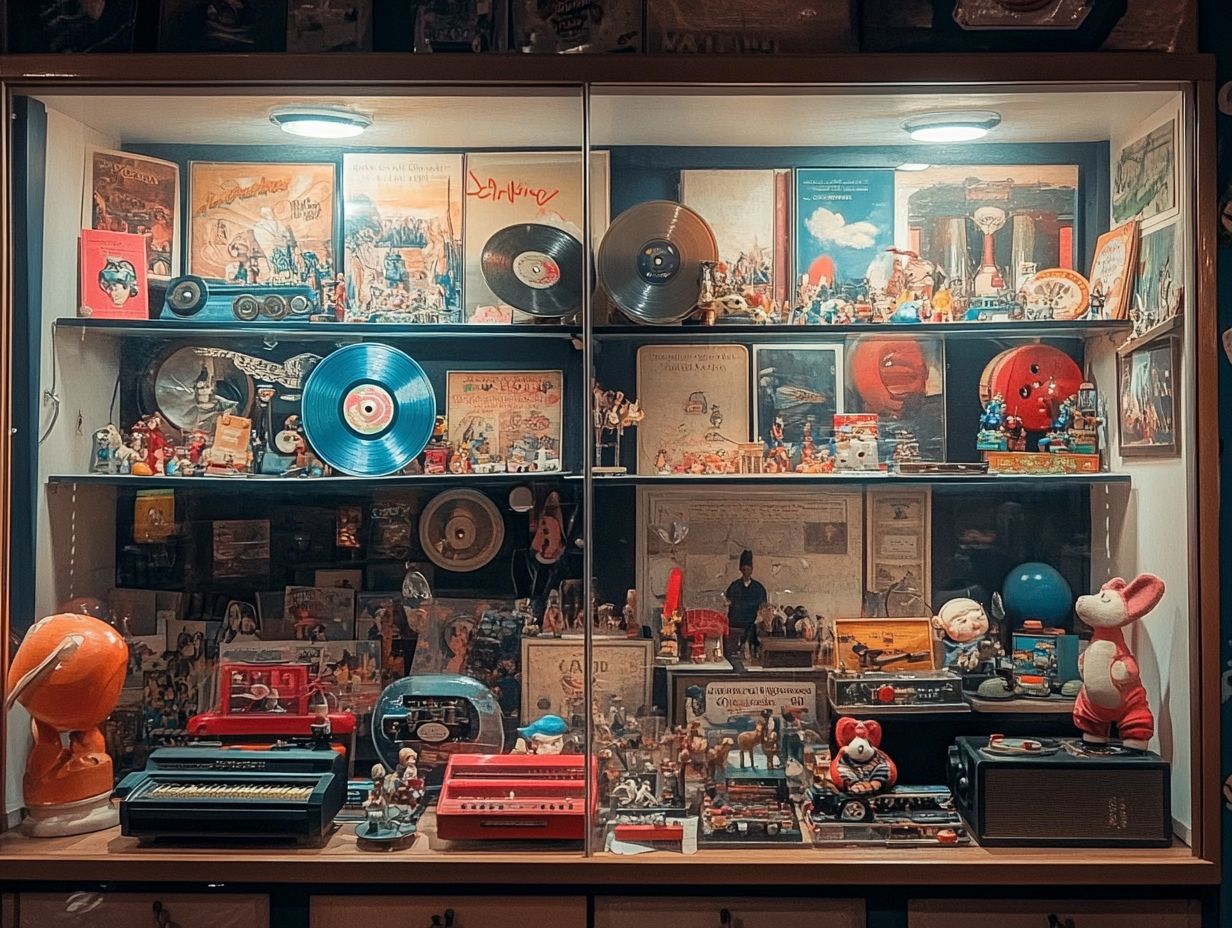
Antiques form a fascinating segment within the vintage collectibles market, distinguished by their rich historical significance and remarkable craftsmanship. These items often date back over a century and serve as tangible links to the past.
As a collector, you re likely drawn to antiques not only for their aesthetic charm but also for the compelling stories they tell. They embody inherent value that connects us to history.
These treasures span a variety of categories, from exquisite furniture and delicate pottery to intricate textiles and fine jewelry. Each piece often represents a unique craft tradition or regional style.
Current market dynamics show a clear trend toward items that are visually stunning and evoke nostalgia or cultural resonance. Many savvy investors recognize antiques as strategic ways to diversify their portfolios, making them popular choices for investors.
Current trends show a growing interest in well-preserved pieces from the Mid-century modern era, which refers to designs from the mid-20th century known for their clean lines and functionality, alongside Victorian artifacts, showcasing a blend of historical appreciation and investment allure.
Memorabilia
Memorabilia encompasses a diverse array of vintage items, often tied to significant cultural events, renowned personalities, or beloved franchises. These items are highly sought after by collectors.
From vintage movie posters to sports memorabilia, these items not only hold emotional value but also serve as tangible connections to cherished memories.
The allure of memorabilia lies in its nostalgia. As a collector, you may find yourself drawn to unique pieces that evoke a sense of belonging, allowing you to connect with moments that have shaped your life.
As market trends shift, certain items such as autographed jerseys or limited-edition toys experience spikes in demand. Take, for example, the iconic ‘Star Wars’ action figures; they have become treasured collectibles, showcasing the fascinating blend of fandom and investment.
Toys and Games
Vintage toys and games represent a captivating realm of collectibles that stir fond childhood memories. They often appreciate in value due to their rarity and condition.
Whether it s classic board games or iconic action figures, these treasures have transformed into prized possessions for those looking to reconnect with their past.
The charm of vintage toys lies in both their delightful aesthetics and the memories they encapsulate. Items like the original Monopoly set or LEGO bricks from the 1960s offer fascinating glimpses into the social culture and entertainment trends of their respective eras.
As you explore flea markets and sift through online auctions, you ll notice the demand for these nostalgic gems continues to grow. This demand is especially strong for items in pristine condition or from limited production runs.
This quest for impeccable specimens underscores how rarity elevates their desirability, making these toys and games not merely relics, but valuable investments that narrate the stories of days gone by.
Comics and Books
Comics and vintage books represent a distinctive niche within the collectibles market. They are cherished not just for their captivating stories and artistry, but also for their rarity and collectible value. As you explore this intriguing realm, you might discover that first editions or limited runs can fetch impressive prices.
Diving deeper into this fascinating world reveals that the condition of these items plays a crucial role in their valuation. Consider mint-condition issues of iconic series like ‘Action Comics No. 1’ or rare works by literary giants such as F. Scott Fitzgerald these can become cornerstones of any serious collection.
Recent trends show a growing interest in lesser-known indie comics and experimental literature. This showcases that the allure of vintage materials extends far beyond mainstream acclaim. This ever-evolving landscape keeps collectors engaged, as they seek out hidden gems that might appreciate in value over time.
Frequently Asked Questions
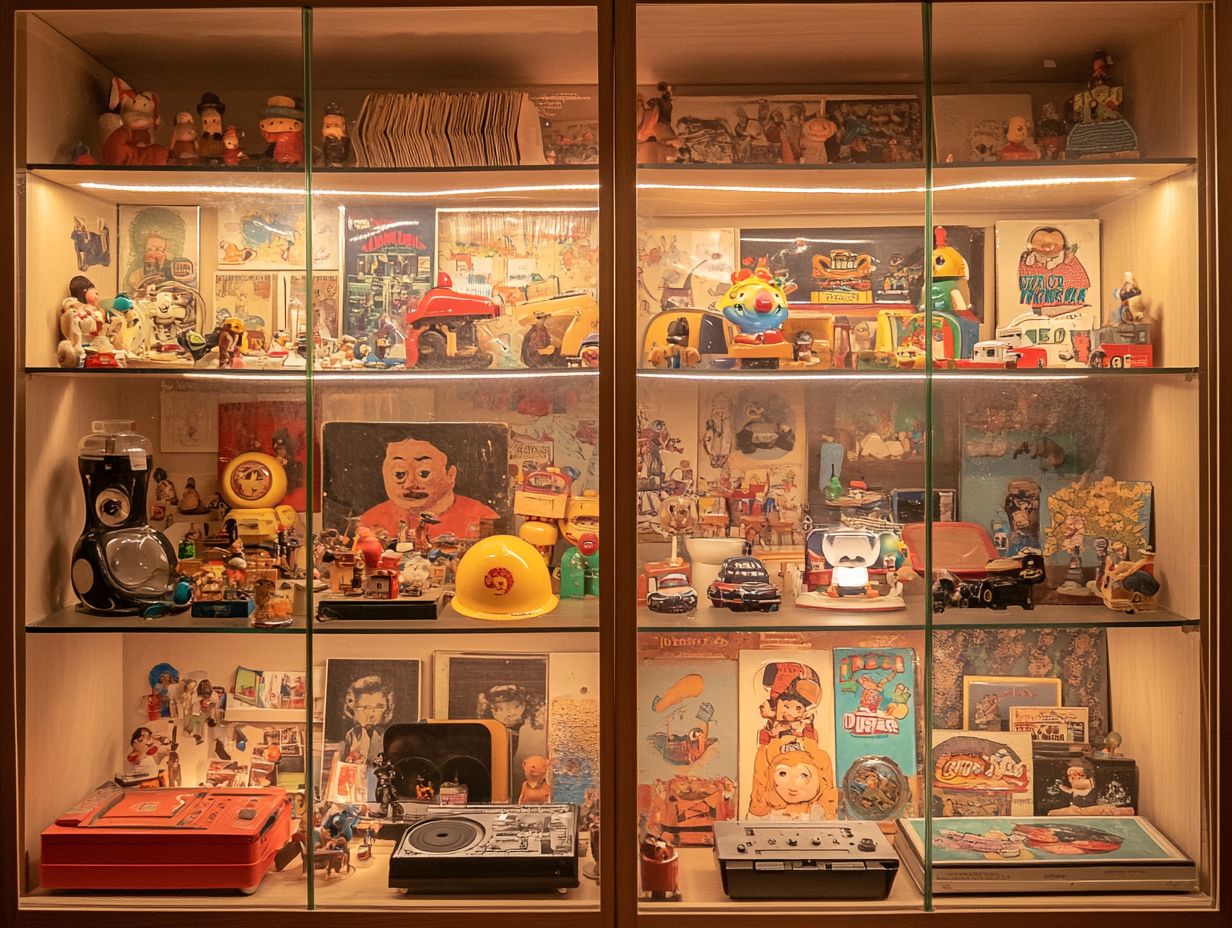
Understanding Vintage Collectibles
What are vintage collectibles?
Vintage collectibles are items that are at least 20 years old and hold value due to their age, rarity, and historical significance.
What are some examples of vintage collectibles?
Examples include antique furniture, vintage clothing and accessories, old books and magazines, retro toys and games, and collectible coins and stamps.
What is the history behind vintage collectibles?
Vintage collectibles have been sought after for centuries, with some of the oldest examples dating back to ancient civilizations such as Egypt and Greece. In more recent times, demand peaked in the 20th century, particularly in the 1950s and 1960s, as nostalgia and interest in retro styles grew.
Valuing Your Collectibles
How are vintage collectibles valued?
Vintage collectibles are valued based on a range of factors, including their age, rarity, condition, and historical significance. Current trends and demand from collectors also impact their value.
Why do vintage collectibles hold value?
They hold value because they offer a glimpse into the past and serve as tangible pieces of history. Additionally, they often carry sentimental value, especially if associated with fond memories or significant events.
How can I determine the value of my vintage collectibles?
The best way to assess the value of your vintage collectibles is to consult with an expert or conduct thorough research on similar items sold in the past. Online marketplaces and auction sites can also provide insights into current market values for specific items.
If you’re passionate about collecting, explore more about the world of vintage collectibles or consult experts directly!



